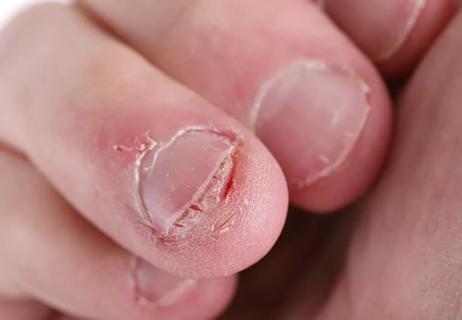Resist the urge to bite, tear or rip off those little pieces of skin

Cold weather brings about a lot of changes in how healthy we feel. From seasonal affective disorder (SAD) to the flu, it seems like the season can wreak havoc on our bodies.
Advertisement
Cleveland Clinic is a non-profit academic medical center. Advertising on our site helps support our mission. We do not endorse non-Cleveland Clinic products or services. Policy
A small, yet annoying, sign that winter is here are hangnails. Those ragged little pieces of skin you find around your nails can be annoying and become irritated if not taken care of properly.
Family medicine specialist Neha Vyas, MD, talks about how to remove a hangnail, what not to do and how to prevent hangnails in the first place.
Even though it’s called a hangnail, that little piece of skin isn’t part of the nail. Instead, it’s a torn piece of skin that hangs loose next to your nails. And it’s rare to have hangnails on your toes, though, it does happen from time to time.
“A hangnail is really short,” says Dr. Vyas. “It’s kind of stiff and it arises from the side of your nail bed.”
Hangnails can be caused by dry air, using alcohol-based hand sanitizers (which we still need to use!) and constant hand washing (which we also still need to do!).
Those with a habit of picking or biting around their nails are likely to get hangnails. Swimming in a chlorinated pool can also cause your skin to dry out and lead to hangnails.
If you enjoy a manicure every now and then, make sure you’re not cutting your cuticles but pushing them back instead. Cutting your cuticles can lead to hangnails and infections.
Advertisement
Follow these steps to safely remove a hangnail.
You may be tempted for a quick fix, but don’t bite, tear, rip or chew off your hangnail, says Dr. Vyas.
“There’s nerves and blood vessels under the hangnail,” says Dr. Vyas. “So you can cause your own bleeding, infection and pain.”
If your hangnail gets infected, you may experience red, irritated skin around the hangnail area. If the infection spreads or worsens, you may get a fever and chills.
A regular hangnail doesn’t typically require a visit to the doctor’s office, but talk to your doctor if you experience the following:
Your doctor may prescribe an antibiotic depending on the level of infection.
Hangnails are easy to prevent. Use these tips to keep the skin on your hands in the best shape:
“The dry air and frequent hand-washing can cause you to be more likely to get a hangnail,” says Dr. Vyas. “Using moisturizer daily can help.”
Advertisement
Learn more about our editorial process.
Advertisement

These manicure techniques vary in terms of longevity, hygiene and overall nail health

A combination of treatments can help you conquer the compulsion

These nail changes could be a sign you had COVID-19

Take these steps to limit the damage

Most recommended precautions center around minimizing bruising or swelling

Even one drink can have an impact on your cognitive function leading to slurred speech, blurred vision and impaired memory

Type 2 diabetes isn’t inevitable with these dietary changes

Applying a hot or cold compress can help with pain